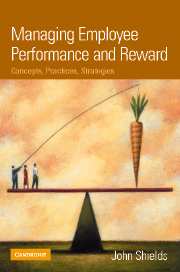Book contents
- Frontmatter
- Contents
- List of figures and tables
- Foreword by John Egan
- Acknowledgements
- Introduction: Setting the scene
- Part 1 The fundamentals
- Part 2 Performance management in action
- Part 3 Base pay and benefits
- 9 Base pay purpose and options
- 10 Base pay structures
- 11 Developing position-based base pay systems
- 12 Developing person-based base pay systems
- 13 Employee benefits
- Case study. Just rewards: Rethinking base pay and benefits at Court, Case & McGowan, commercial law partners
- Part 4 Rewarding employee performance
- Part 5 Fitting it all together
- Model responses to case studies
- References
- Index
9 - Base pay purpose and options
from Part 3 - Base pay and benefits
- Frontmatter
- Contents
- List of figures and tables
- Foreword by John Egan
- Acknowledgements
- Introduction: Setting the scene
- Part 1 The fundamentals
- Part 2 Performance management in action
- Part 3 Base pay and benefits
- 9 Base pay purpose and options
- 10 Base pay structures
- 11 Developing position-based base pay systems
- 12 Developing person-based base pay systems
- 13 Employee benefits
- Case study. Just rewards: Rethinking base pay and benefits at Court, Case & McGowan, commercial law partners
- Part 4 Rewarding employee performance
- Part 5 Fitting it all together
- Model responses to case studies
- References
- Index
Summary
We begin our coverage of remuneration practice by considering what, for most employees, is the primary component of their total remuneration, namely base pay. The chapter opens with a discussion of the general nature and logic of base pay. We then consider the two broad alternative approaches to configuring base pay – pay for the position (or ‘job-based’ base pay), and pay for personal skills and personal competencies (or ‘person-based’ base pay) – and the general arguments for and against each. The chapter also examines evidence on the comparative incidence of job-, skill- and competency-based pay in various countries, noting that while the two person-based approaches have assumed growing importance in base pay practice since the 1980s, the take-up of person-based practices varies considerably from country to country, sector to sector, organisation to organisation and occupation to occupation.
‘Base pay’: what and why
Base pay is the foundational component of total remuneration, and it can be defined as the part of an employee's direct remuneration that is not performance-contingent. It is commonly viewed as the ‘fixed’ or ‘guaranteed’ portion of pay in that it is chiefly time-based rather than performance-based. For each quantum of time worked, the employee receives a predetermined amount of pay. In broad terms, time-based pay can be delivered either as an hourly, daily or weekly wage, or in the form of an annual salary. It is also typically the largest component of total pay for non-executive employees.
- Type
- Chapter
- Information
- Managing Employee Performance and RewardConcepts, Practices, Strategies, pp. 233 - 248Publisher: Cambridge University PressPrint publication year: 2007



